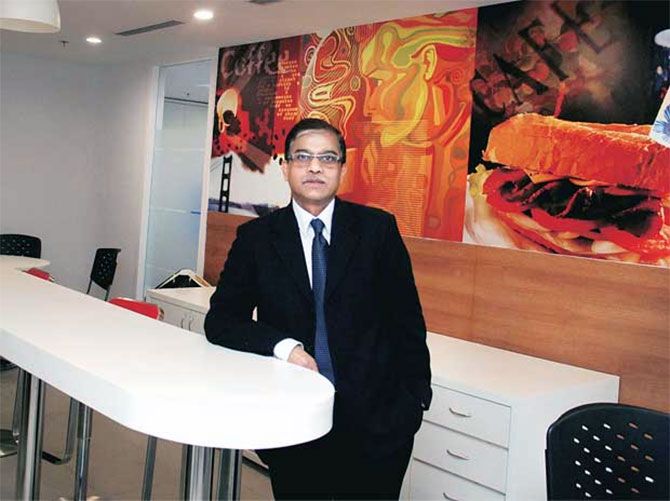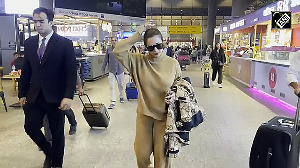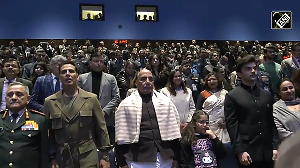GSTN CEO Prakash Kumar tells Sudipto Dey how information technology can improve service delivery of government departments.

Our guest is a self-confessed non-foodie. Given a choice he would eat home food at the Goods and Services Tax Network (GSTN) canteen on the fourth floor office at Worldmark 1 in Aerocity complex near Terminal 3 of the New DelhiAirport.
Despite repeated attempts to meet at a restaurant of his choice -- and there are plenty of them within the Aerocity complex -- Prakash Kumar leaves it to us to decide on the place for our meeting.
To get more bang out of the time allotted for the midweek lunch meeting -- roughly around 90 minutes -- we zero in on Bella Italia at Holiday Inn. While the user reviews of the United Kingdom-based restaurant chain on various websites were largely positive, what clinched the choice of place was the fact that it was just next door to the GSTN office -- at best five minutes away.
As we walk into Holiday Inn, Kumar, the CEO of GSTN, confesses that he has been to this hotel only once for a meeting and this was his first visit to the restaurant. "This shows you how much of a foodie I am," he chuckles.
Though we had pre-booked a table for two, actually there was no need. At 1 pm, the restaurant was largely empty.
We settle down in a corner by two large windows. Both of us decide to order the food before starting off with our conversation.
After scanning the menu, Kumar suggests it would be a better idea to take the help of the restaurant staff. "I am allergic to shrimps and want to avoid sea food," he instructs the person serving our table.
We decide to share the pasta and lasagne, settling for Agnello Tagliatelle (prepared from fresh egg tagliatelle with slow cooked lamb) and Pollo Pancetta (fresh pasta with slices of chicken breast, crispy pancetta in cheese sauce and mozzarella).
We kick off our conversation with Kumar's active interest in the Right to Information (RTI) movement.
As information technology (IT) secretary with the government of India he worked closely with setting up the technology backbone for the RTI system in the mid-2000s.
Earlier, in the 1990s, he was involved in automating the sales tax department for the Delhi government. He has co-authored three books on RTI while in government
He concedes that he did not know much about RTI till he saw an opportunity to use the IT platform to make information available to stakeholders.
"The idea was to create a Google for government information -- answer anything people ask about government services, put that out in the public domain," he says.
In his two-decade-long stint in the government, the 1985 batch IAS officer has observed that "mal-administration happens when stakeholders do not have information".
The IIT Kanpur alumnus strongly feels that IT has to be used as a platform to improve the service delivery of government departments. "My entire work over the last 20 years has been in this area," he says.
So, when the offer came up to join GSTN he did not hesitate to take a salary cut to be part of -- as he puts it -- "one of the biggest tax reforms the country has seen".
Kumar had left government in 2008 to join the corporate sector and had stints with technology giants Cisco and Microsoft. Just like the Unique Identification project created a platform, GSTN -- the technology backbone for GST -- will be a platform for the indirect tax system.
"We are also creating a platform on which many other things can be done apart from GST compliance," he says.
Services that the GSTN backbone can offer include verifying whether one is registered with the tax department or have a rating service on the lines of credit rating. The network has already been integrated for PAN verification, with the Ministry of Corporate Affairs for DIN verification, and with UID for Aadhaar verification.
Ten minutes into our conversation the food is served -- the quickness of the service take both of us by surprise. As we dig into the pasta and lasagne, Kumar appears pleased with the choice. "This is good. I should come here more often," he says.
Going back to our conversation we decide to talk about some recent controversies surrounding the project. This includes issues around its ownership, the role of the private sector, data protection among others.
"There is no controversy around GSTN, just lack of information," says Kumar.
So, following his lessons from the RTI project, Kumar decided one day to put all information relating to the organisation into the public domain through FAQs on the GSTN website. "I just wrote all the answers on the website and put it out," he says.
It worked.
Over the last couple of months there are fewer questions around the GSTN project, he says.
The government created GSTN as a private not-for-profit company, but with complete strategic control with the government. Forty nine per cent of the shares are held by government, equally between the Centre and the state governments, and the remaining 51 per cent is with private financial institutions.
The Centre and the states have six directors on the board while private financial institutions have -- even with 51 per cent ownership -- three directors.
The two independent directors on the board are a former IT secretary of the government of India and a retired deputy governor of the Reserve Bank of India.
"The structure was created to give flexibility to recruit people from the technology sector at market rate salaries. The second reason was to give agility to the organisation to take quick decisions," says Kumar.
On the issue of auditing of the project, Kumar clarifies that GSTN was audited by the Comptroller and Auditor General (CAG) for the first three years.
"Apart from that there is a statutory auditor and an internal auditor chosen from a CAG-approved panel," he says.
On recent charges of service tax evasion Kumar seems a bit circumspect.
"This was due to some misunderstanding or lack of understanding about something," he says.
The tax department has asked for details of book of accounts and the grant provided by government.
"We have provided them all the details," he says.
He is quick to add that one learns to handle uncomfortable questions around projects after being in the government for 23 years. "You should take pinpricks in good stride, why bother," he says.
The pushback of GST roll-out by three months to July 1 has come as a big breather for the project, concedes Kumar.
"Our only request to the government has been to give the final rules quickly," he says.
With the biggest roadblock of dual control cleared, the rest will fall in place in due course, says Kumar.
The plan is to unveil the GSTN software in April for tax officers to work and play around with.
"They can give suggestions for further improvements," he says. Around 2,000 tax officers have been trained as master trainers in the use of the software.
From the middle of May, the system would be opened up for some taxpayers as decided by the tax authorities.
"Depending on the feedback we will clean up the system, sanitise it and be ready by the last week of June for the July roll-out," says Kumar.
We finish our main course in barely 30 minutes, but Kumar is reluctant to have dessert.
"I am not a diabetic, but have been advised to avoid sweets. I am a borderline case," he says defensively.
We finally agree to have a cookie dough lava cake, served with molten choco and warm caramel sauce and vanilla gelato.
As he digs into the cake, there is a sense of familiarity in his facial expression. "My wife tries something similar at home once in a while," he says, perhaps reading my thoughts.
In the last lap of our conversation -- for around an hour -- Kumar delves into what will keep him awake if GST rolls out on July 1.
A lot of things, he says. Primary among them would be sheer availability of the system and its response time. Then one has to watch out for break-in.
"There could be break-in attempts by hackers" he says candidly.
In fact, there was a massive hacker attack on the system on November 8 last year when the GSTN opened for registration,
Kumar says matter-of-factly.
"But the team was able to ward it off — thereafter access to the portal from outside the country has been disabled," he says. "We do anticipate huge attempts to break the system when we roll out."
On that note Kumar looks at his watch and realises that we are well past his 2 pm deadline to wrap up the meeting.











 © 2025
© 2025